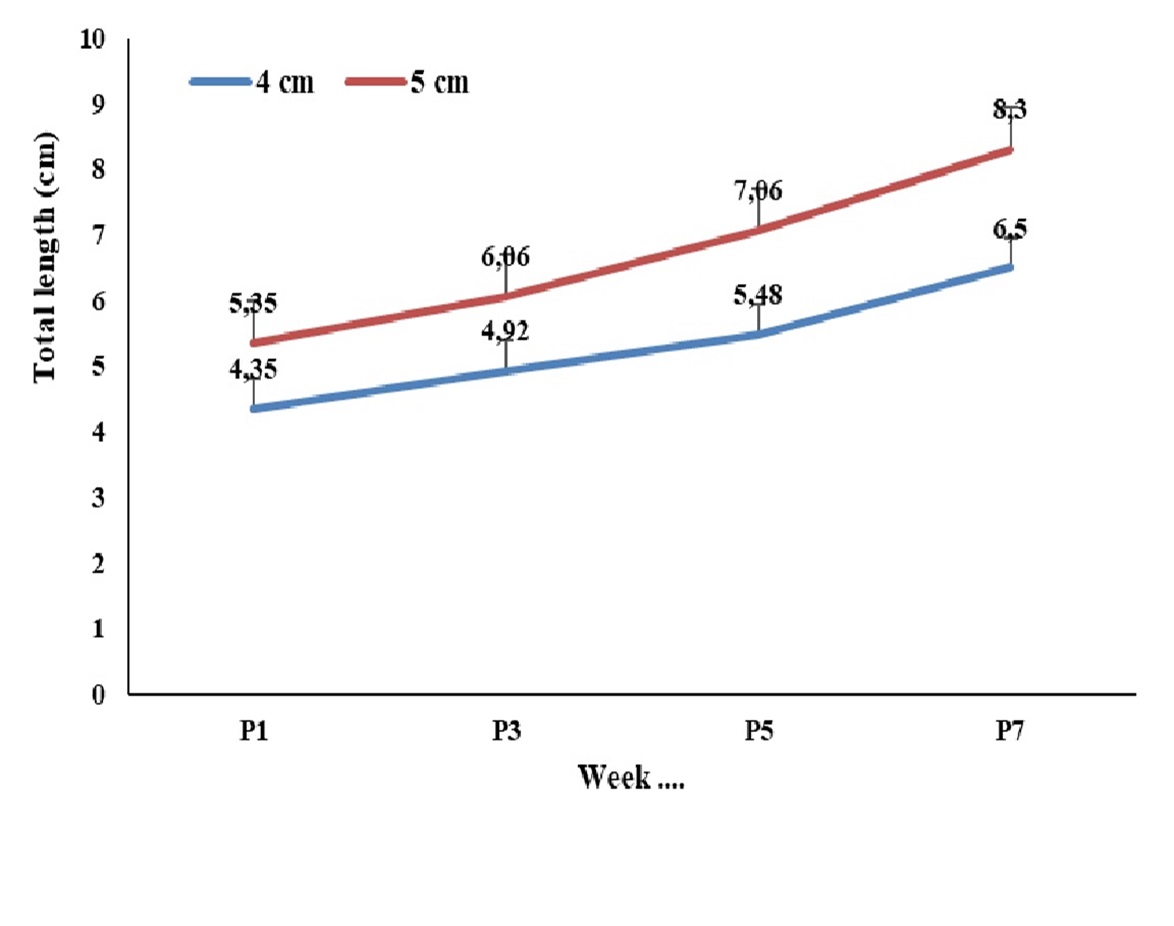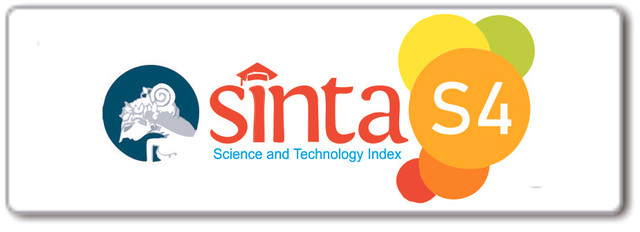Growth performance of white seabass (Lates calcarifer) cultivated using recirculation aquaculture system (RAS)
Abstract
White seabass (Lates calcarifer) is classified as a fishery commodity that has a high selling value with an easy cultivation method. However, water quality is an obstacle in the fish cultivation process. Therefore, it is necessary to implement an appropriate cultivation system, including a recirculation aquaculture system (RAS). RAS is reuse of water that has been used through a filter so that fish with high growth and survival are obtained. The aim of the research was to analyze the growth performance of white seabass cultivated with RAS. The research was conducted at the Mariculture Laboratory of the Aquaculture Technology Study Program, Tual State Polytechnic of Fisheries in June to August 2024. The research was used a descriptive type with initial length measurements (4 and 5 cm) and was repeated 3 times. A total of 10 fish were kept in a hapa in a rearing tank and equipped with RAS using sand and charcoal filters. Growth performance were measured included body length, body weight, growth rate, and survival rate. The research results show that the RAS system determines the growth performance of white seabass. This is evidenced by the increasing average increase in length and body weight. At an initial length of 4 cm, the average increase was 6.5 cm and 4.25 g, while at an initial length of 5 cm it was 8.3 cm and 6.5 g. The average survival rate was 75% at an initial fish size of 4 cm and 86% at an initial fish size of 5 cm. Thus, the RAS system can be applied in white seabass cultivation.
Downloads
References
Alem, M. D. B. A., Eko, E., Wardiyanto., & Sarwono, H. A. 2018. Studi pengurangan amonia pada pendederan ikan kakap merah Lutjanus sp dengan sistem resirkulasi. Jurnal Sains Teknologi Akuakultur, 2(2): 41– 47.
Candra, H. K., Cahyani, R. F., Bahit, M., Noor, S., & Mulyani, D. 2023. Pembuatan kolam tarpaulin fish budidaya ikan air tawar sistem resirkulasi warga aliran Sungai Kemuning Banjarbaru Kalimantan Selatan. Wahana Dedikasi: Jurnal PkM Ilmu Kependidikan, 6(2): 255–263.
Chen, S., Su, Y., & Hong, W. 2018. Aquaculture of LARGE YELLOW CROAKER. Aqua Culture in China. Success Stories and Modern Trends. John Willey & Sons.
Drengstig, A., & Bergheim, A. 2013. Commercial landbased farming of european lobster (Homarus gammarus L.) in recirculating aquaculture system (RAS) using a single cage approach. Journal of Aquacultural Engineering, 53: 14-18.
Effendie, M. I. 2002. Biologi Perikanan. Yayasan Pustaka Nusatama. Yogyakarta.
Effendy, I. J., Nurdin, A. R., Mu’minun, N., Ridwar, D., & Saridu, S. A. 2022. Studi makroalga sebagai biofilter terhadap pertumbuhan dan sintasan juvenil abalon (Haliotis asinina) pada sistem budidaya resirkulasi. Jurnal Salamata, 4(2): 42–50.
Elinah & Sadisasmita, P. 2024. Pengaruh penggunaan sistem resirkulasi akuakultur (ras) terhadap kualitas air dan produksi ikan. Jurnal Review Pendidikan dan Pengajaran, 7(3): 9388-9393.
Fitrniawati, H., & Utami, E. S. 2023. Performa Pertumbuhan Kakap Putih (Lates calcarifer) dalam Karamba Jaring Apung, Tual, Maluku. Jurnal Sains dan Inovasi Perikanan, 7(2): 158-165.
Gullian-Klanian, M., & Arámburu-Adame, C. 2013. Performance of nile tilapia Oreochromis niloticus fingerlings in a hyper-intensive recirculating aquaculture system with low water exchange. J. Aquat. Res, 41(1): 150-162.
Gusrina. (2008). Budidaya Ikan. Jakarta: Direktorat Pembinaan Sekolah Menengah Kejuruan Direktorat Jenderal Manajemen Pendidikan Dasar dan Menengah Departemen Pendidikan Nasional.
Hapsari, A. W., Hutabarat, J., & Harwanto, D. 2020. Aplikasi komposisi filter yang berbeda terhadap kualitas air, pertumbuhan dan kelulushidupan ikan nila (Oreochromis niloticus) pada sistem resirkulasi. Sains Akuakultur Tropis, 4(1): 39–50.
Klanian M. G., & Adame, C. A. 2013. Performance of nile tilapia (Oreochromis niloticus) fingerlings in a hyper-intensive recirculating aquaculture system with low water exchange. Latin American Journal of Aquatic Research, 41(1): 150-162.
Mangkurat, W., Nurdiana, E., & Budianto, A. 2019. Penurunan kadar amonia , nitrit, dan nitrat pada air sungai menggunakan karbon aktif sebagai solusi niefisiensi chlorine. Saintek, 7(1): 279–284.
Matondang, M. A. Z., Irawan, H., & Yulianto, T. 2021. Pengaruh berat pecahan arang kelapa yang berbeda sebagai filter dalam mempertahankan kualitas air pada pemeliharaan benih ikan kakap putih (Lates calcarifer). Intek Akuakultur, 5(2): 100-112.
Noor, N. M., & Aziz, R. 2023. Nursery of white shrimp (Litopenaeus vannamei) with biofloc system. Indonesian Journal of Fisheries Community Empowerment, 3(2): 226-233.

Copyright (c) 2024 Helena Afia Sahusilawane, Jacomina Metungun, Henny Fitrinawati, Juliana Ester Kilmanun

This work is licensed under a Creative Commons Attribution-NonCommercial-ShareAlike 4.0 International License.
Authors who publish with BIOEDUPAT: Pattimura Journal of Biology and Learning agree to the following terms:
- Authors retain copyright and grant the journal right of first publication with the work simultaneously licensed under a Creative Commons Attribution License (CC BY-NC-SA 4.0) that allows others to share the work with an acknowledgment of the work's authorship and initial publication in this journal.
- Authors are able to enter into separate, additional contractual arrangements for the non-exclusive distribution of the journal's published version of the work (e.g., post it to an institutional repository or publish it in a book), with an acknowledgment of its initial publication in this journal.
- Authors are permitted and encouraged to post their work online (e.g., in institutional repositories or on their website) prior to and during the submission process, as it can lead to productive exchanges, as well as earlier and greater citation of published work.








 This work is licensed under a
This work is licensed under a 